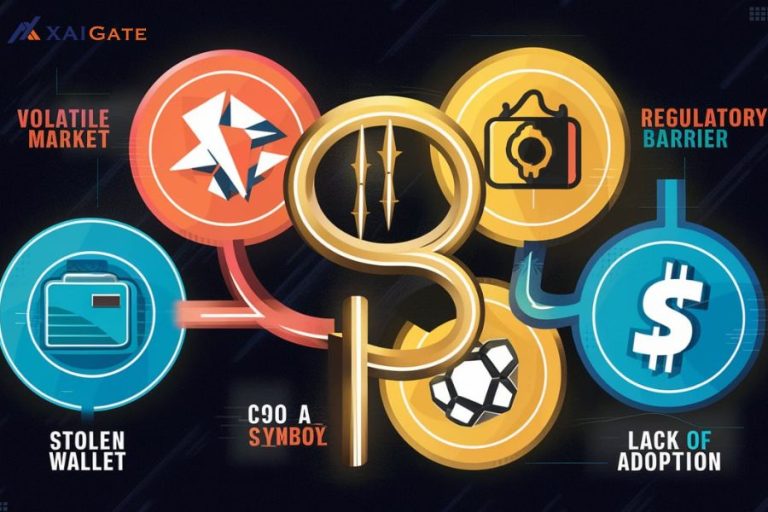Cryptocurrencies make use of a decentralized network running on blockchain technology which helps in recording and authenticating trades. Unlike common forms of money, they are based on cryptographic methods to secure trades and regulate the generation of fresh units. “How cryptocurrency works? ” explains some fundamental things about electronic wallets, mining operations as well as underlying concepts in blockchain. Perplexity and burstiness measures will be used to guide the AI in forming comprehensible human-like sentences from text generated by its MELISSE parser-generated text generator. Let’s dive into this topic more deeply with XAIGATE in this article.

What is cryptocurrency?
Cryptocurrencies are virtual currencies that rely on cryptography for security purposes making it impossible to forge the same currency more than once or spend it twice. This is based on the concept of decentralized networks with blockchains running on each computer connected to one another in a network that enforces a ledger system. Some notable examples are Bitcoin and Ethereum, as they facilitate safe online transactions, with no central authority needed like banks.

How cryptocurrency works?
Cryptocurrencies come into existence through a procedure referred to as mining, whereby strong computers tackle difficult mathematical queries so as to certify and maintain records of dealings undertaken on a network known as blockchain. This necessitates a huge amount of computational power as well as electricity and miners are compensated for their labor with fresh tokens used as a medium of exchange other than cash. However, not all currencies follow this path since some are already produced in advance before being given out using ICOs while others have not gone through any mining processes at all but all are still termed as virtual currencies.

>>>Learn more about crypto payment gateways: Best 4 Cryptocurrency Payment Gateway for Website
Cryptocurrency vs traditional currency
How cryptocurrency works differs from traditional currencies by being decentralized and operating on blockchain technology, thereby eliminating the need for a central authority such as a bank. Governments issue traditional fiat money and it is controlled by banks, which are physical cash forms and centralize digital records. Cryptocurrencies are more transparent and secure, but their prices are much less stable than those of traditional currencies that have hardly ever changed throughout history.

What are the advantages of cryptocurrency?
The technological advances of the contemporary world may result in significant impacts on society. Financial institutions are increasingly relying on electronic systems for their customers to manage bank accounts remotely. Besides, cryptocurrency payments platform transactions are usually faster with lower fees compared to conventional banking and wire transfer services.

>>>Learn more about crypto payment: Top 3 Cheapest Cryptocurrency Payment Gateway on the Market
Types of cryptocurrency
Many forms of cryptocurrencies exist, Bitcoin being the first and the most popular one, used mainly as a digital currency payment. Others such as Ethereum as well as other altcoins such as Ethereum implement various features like smart contracts that empower decentralized apps with more intricate exchanges, among other things. In addition, there are stablecoins that are created in a bid to keep their values constant by tying them to real world equivalents such as the US dollar hence reducing volatility among other things in the world of crypto-currency.

How to get started with cryptocurrencies
Before dealing with cryptocurrencies, choose a secure exchange and store coins in a safe digital wallet. Understand blockchain operations, trade safely, and monitor market trends to make informed decisions.

Create and fund your account.
To establish and finance your crypto payments account, first sign up at a reputable exchange platform, go through the required verification procedures to shield it. After that link it with your bank account or another payment method so that you could add money there easily. After you might have done this, buy desired cryptocurrencies with these funds and send them over to your safe digital wallet where they will be kept safely ever after.
Buy crypto.
To understand how cryptocurrency works, start by logging into your exchange account. From there, navigate to the trading section where you can easily select the type of digital asset you wish to purchase. Indicate the specific quantity that you are willing or able to pay for and go through entire details concerning transaction inclusive rating charges besides current prices just before placing an order for it. Afterwards, after receiving part of what had been paid or disbursed within specified periods before finalizing such things online at home – after which virtual currencies can either be transferred onto another platform (or even physical storage).
Select a storage method.
To decide on the appropriate storage system for your virtual money, you need to consider a hardware wallet, characterized by a high level of security and use of offline storage, and a software wallet meant for easier access and online storage. Think about a hardware wallet for the security of huge funds or if you intend to do long-term investments. Conversely, rapid trading and online threats could make software wallets more preferable although they allow quick access for this type of money.”
- Hot wallets: Hot wallets are digital wallets behind secure servers that are available on the internet. Although it can be convenient to spend money quickly and easily, they are more vulnerable to attack compared to their offline counterparts.
- Cold wallets: Cold wallets are offline storage solutions for cryptocurrencies. They offer more protection because they keep digital investments off the Internet. Even though perfect for saving over years, they can be inconvenient during most trades.
Ready to get started with cryptocurrency?
How cryptocurrency works? And are you set to start engaging in cryptocurrency? Before buying or managing coins, first understand the basics of digital assets and pick out an excellent platform. If a person has proper tools as well as understanding then he/she’ll soon find his/her way around this fantastic new area called Cryptocurrency!

Bitcoin and Cryptocurrency Technologies
The use of blockchain in enabling institutions to facilitate transactions without intermediaries, is reshaping finance bit by bit. What Bitcoin payment – as a technology mover or shaker – shows is how virtual currencies might work without following in the footsteps of conventional bank systems. It is clear that these aspects show us direction towards future financial transactions, which are not only faster but also easier because they reduce bureaucracy by becoming more open or decentralized.

Blockchain and Cryptocurrency Explained
Understanding how cryptocurrency works involves recognizing that blockchain and cryptocurrency are fundamentally connected, with blockchain serving as the backbone of the cryptocurrency system. All transactions are securely recorded and verified over a distributed network by this decentralized ledger technology. Cryptocurrencies have embraced the use of blockchain technology as a way of conducting transactions without relying on banks hence presenting an innovative way to handle finances and assets.

>>> You might be interested in: What Can You Buy with Cryptocurrency? 3 Types of Purchases
Conclusion
Undergoing cryptocurrency operation details will uncover a different ground of electronic finances, because one would be able to discover other subjects regarding prerequisites of block chain, mining and digital wallets, this would help newcomers to familiarize themselves with what they are getting into. By understanding how cryptocurrency works, they become well-prepared to make the most of the rapidly changing cryptocurrency world with Bitcoin and other Crypto Payment Processor, rather than getting lost along the way.
XAIGATE is a secure and user-friendly crypto payment gateway that allows businesses to accept cryptocurrency payments from customers around the world. With WooCommerce Crypto Payment Gateway for WordPress, businesses can easily integrate cryptocurrency payments into their existing websites or online stores.









What is blockchain technology, and how does it serve as the foundation for cryptocurrencies like Bitcoin?
Blockchain technology is a decentralized and distributed digital ledger that records transactions across multiple computers in a secure, transparent, and immutable way. It serves as the foundation for cryptocurrencies like Bitcoin by enabling trustless peer-to-peer transactions without the need for intermediaries, such as banks.
In a blockchain, data is stored in blocks, and each block is linked to the previous one using cryptographic hashes, forming a chain. This structure ensures that once a block is added to the chain, it cannot be altered without changing all subsequent blocks—a process that is virtually impossible due to the computational power required.
Cryptocurrencies use this technology to maintain a secure and tamper-proof record of transactions. For example, Bitcoin transactions are validated by a network of computers (called nodes) through a process known as mining, which solves complex mathematical problems to confirm and add transactions to the blockchain. This ensures the integrity, security, and transparency of the currency.
Blockchain’s decentralized nature means no single entity controls it, making cryptocurrencies resistant to censorship and fraud.
What are the basic principles behind how cryptocurrency works, and what should beginners understand before getting started?
Cryptocurrency can be a complex subject, but understanding its basic principles is essential for anyone looking to get started. Here’s a simple beginner’s guide to how cryptocurrency works:
1. What is Cryptocurrency?
Cryptocurrency is a digital or virtual currency that uses cryptography for security. Unlike traditional currencies like the dollar or euro, cryptocurrencies operate independently of a central bank or government. The most well-known cryptocurrency is Bitcoin (BTC), but there are thousands of others, such as Ethereum (ETH), Litecoin (LTC), and Ripple (XRP).
2. Blockchain Technology
At the core of most cryptocurrencies is a technology called blockchain. A blockchain is a distributed ledger that records all transactions across a network of computers. Each transaction is grouped into a “block,” which is linked to the previous one, creating a chain of blocks. This makes the ledger secure, transparent, and immutable.
How it works: When you make a cryptocurrency transaction, it is verified by the network and added to the blockchain. Once recorded, the transaction cannot be altered or deleted.
3. Decentralization
One of the key features of cryptocurrency is that it is decentralized. Unlike traditional banking systems, which are controlled by central authorities (like banks or governments), cryptocurrency operates on a peer-to-peer network. This means that transactions occur directly between users without the need for intermediaries.
How it works: When you send cryptocurrency to someone, the transaction is verified by other network participants (called miners or validators), ensuring that both parties have the necessary funds. This decentralization enhances security and transparency.
4. Wallets and Keys
To use cryptocurrency, you need a digital wallet. A wallet stores your private keys, which are used to access your crypto holdings. Your public key is like your account number, and your private key is like your password. Protecting your private key is essential because if someone else gains access to it, they can control your funds.
How it works: Wallets can be software-based (online, desktop, or mobile wallets) or hardware-based (physical devices that store keys offline). You use your private key to sign transactions and prove ownership of your crypto.
5. Mining and Consensus Mechanisms
Most cryptocurrencies rely on a process called mining (or staking in some cases) to validate and secure transactions. Miners use powerful computers to solve complex mathematical problems that verify transactions and add them to the blockchain. In exchange for their work, miners are rewarded with new coins.
How it works: For Proof of Work (PoW) cryptocurrencies like Bitcoin, miners compete to solve cryptographic puzzles. In Proof of Stake (PoS) systems, validators are chosen to create new blocks based on the number of coins they hold and are willing to “stake” as collateral.
6. Transactions and Fees
When you send cryptocurrency, you typically have to pay a transaction fee, which compensates miners or validators for their work in securing the network. Fees can vary depending on the cryptocurrency and network congestion.
How it works: Transaction fees are often small but can fluctuate based on demand for processing transactions. These fees help ensure that the network remains secure and efficient.
7. Security and Transparency
One of the key benefits of cryptocurrency is its security. The blockchain makes transactions highly secure due to the cryptographic algorithms used to secure the data. Furthermore, because the blockchain is public, anyone can verify transactions, making the system transparent.
How it works: Every transaction is recorded on the blockchain and visible to anyone who checks the ledger. This prevents fraud, double-spending, and other malicious activities.
8. The Role of Cryptocurrency Exchanges
If you want to buy or sell cryptocurrencies, you typically use a cryptocurrency exchange like XAIGATE, Coinbase, or Binance. These platforms allow you to trade cryptocurrencies, convert them into fiat currency, and transfer funds between wallets.
How it works: You create an account, deposit fiat or crypto, and then use the exchange to buy or sell digital assets. The exchange acts as an intermediary but still maintains decentralization in the sense that it doesn’t control your assets.
Key Benefits of Cryptocurrency:
Low Transaction Fees: Cryptocurrency transactions generally have lower fees compared to traditional banking systems.
Security: Cryptographic encryption and decentralization make crypto transactions more secure than traditional digital payments.
Transparency: Blockchain ensures that all transactions are publicly verifiable.
Global Access: Cryptocurrency can be sent anywhere in the world, allowing for cross-border payments without high fees.
Conclusion:
To summarize, cryptocurrency is a digital form of money that operates on a decentralized network, leveraging blockchain technology for security and transparency. It offers a variety of benefits, such as low transaction fees, global reach, and increased security. As a beginner, understanding the basic principles of cryptocurrency, wallets, and mining can help you navigate the space and start investing or using crypto safely and effectively.
How are transactions verified in cryptocurrency networks?
Using XAIGATE, cryptocurrency transactions are verified through secure and efficient blockchain technology. XAIGATE leverages advanced consensus mechanisms to ensure accurate and trustworthy transaction validation, preventing fraud and double-spending.